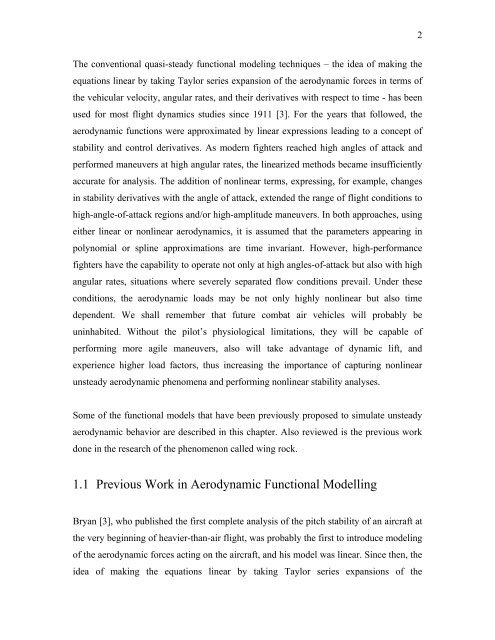Aircraft Stability Analysis Including Unsteady Aerodynamic Effects
Aircraft Stability Analysis Including Unsteady Aerodynamic Effects
Aircraft Stability Analysis Including Unsteady Aerodynamic Effects
You also want an ePaper? Increase the reach of your titles
YUMPU automatically turns print PDFs into web optimized ePapers that Google loves.
2The conventional quasi-steady functional modeling techniques – the idea of making theequations linear by taking Taylor series expansion of the aerodynamic forces in terms ofthe vehicular velocity, angular rates, and their derivatives with respect to time - has beenused for most flight dynamics studies since 1911 [3]. For the years that followed, theaerodynamic functions were approximated by linear expressions leading to a concept ofstability and control derivatives. As modern fighters reached high angles of attack andperformed maneuvers at high angular rates, the linearized methods became insufficientlyaccurate for analysis. The addition of nonlinear terms, expressing, for example, changesin stability derivatives with the angle of attack, extended the range of flight conditions tohigh-angle-of-attack regions and/or high-amplitude maneuvers. In both approaches, usingeither linear or nonlinear aerodynamics, it is assumed that the parameters appearing inpolynomial or spline approximations are time invariant. However, high-performancefighters have the capability to operate not only at high angles-of-attack but also with highangular rates, situations where severely separated flow conditions prevail. Under theseconditions, the aerodynamic loads may be not only highly nonlinear but also timedependent. We shall remember that future combat air vehicles will probably beuninhabited. Without the pilot’s physiological limitations, they will be capable ofperforming more agile maneuvers, also will take advantage of dynamic lift, andexperience higher load factors, thus increasing the importance of capturing nonlinearunsteady aerodynamic phenomena and performing nonlinear stability analyses.Some of the functional models that have been previously proposed to simulate unsteadyaerodynamic behavior are described in this chapter. Also reviewed is the previous workdone in the research of the phenomenon called wing rock.1.1 Previous Work in <strong>Aerodynamic</strong> Functional ModellingBryan [3], who published the first complete analysis of the pitch stability of an aircraft atthe very beginning of heavier-than-air flight, was probably the first to introduce modelingof the aerodynamic forces acting on the aircraft, and his model was linear. Since then, theidea of making the equations linear by taking Taylor series expansions of the
















